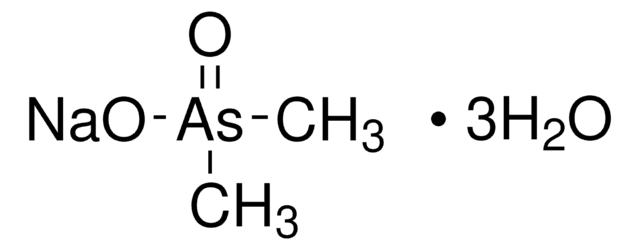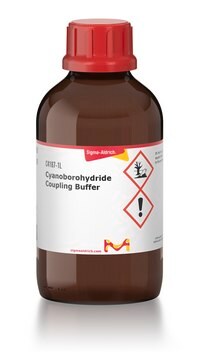G7651
Glutaraldéhyde solution
Grade I, 50% in H2O, specially purified for use as an electron microscopy fixative or other sophisticated use
Synonyme(s) :
Dialdéhyde glutarique solution, Pentane-1,5-dial
About This Item
Produits recommandés
Niveau de qualité
Type
Grade I
Forme
liquid
Concentration
50% in H2O
Technique(s)
electron microscopy: suitable (fixative)
Couleur
colorless
Pf
-21 °C ((-6 °F))
Solubilité
water: soluble
Conditions d'expédition
dry ice
Température de stockage
−20°C
Chaîne SMILES
[H]C(CCCC([H])=O)=O
InChI
1S/C5H8O2/c6-4-2-1-3-5-7/h4-5H,1-3H2
Clé InChI
SXRSQZLOMIGNAQ-UHFFFAOYSA-N
Vous recherchez des produits similaires ? Visite Guide de comparaison des produits
Description générale
Application
- along with 4-(2-hydroxyethyl)-1-piperazineethanesulfonic acid (HEPES) buffer to fix the concentrated extracellular vesicles (EVs) on concanavalin A for scanning electron microscope (SEM)
- as a component in a solution to fix the cells to observe its morphology
- to fix the Escherichia coli cells in aqueous solution to preserve the surface morphology of bacterial cells
Actions biochimiques/physiologiques
Caractéristiques et avantages
- Highly efficient and safe to use with lensed instruments, rubber, or plastics
- Non-corrosive to metals
- Minimum shelf life of 14 days
Autres remarques
Clause de non-responsabilité
Mention d'avertissement
Danger
Mentions de danger
Classification des risques
Acute Tox. 3 Inhalation - Acute Tox. 4 Oral - Aquatic Acute 1 - Aquatic Chronic 2 - Eye Dam. 1 - Resp. Sens. 1 - Skin Corr. 1B - Skin Sens. 1 - STOT SE 3
Organes cibles
Respiratory system
Risques supp
Code de la classe de stockage
6.1A - Combustible acute toxic Cat. 1 and 2 / very toxic hazardous materials
Classe de danger pour l'eau (WGK)
WGK 3
Point d'éclair (°F)
Not applicable
Point d'éclair (°C)
Not applicable
Faites votre choix parmi les versions les plus récentes :
Déjà en possession de ce produit ?
Retrouvez la documentation relative aux produits que vous avez récemment achetés dans la Bibliothèque de documents.
Les clients ont également consulté
Contenu apparenté
Three-dimensional (3D) printing of biological tissue is rapidly becoming an integral part of tissue engineering.
Notre équipe de scientifiques dispose d'une expérience dans tous les secteurs de la recherche, notamment en sciences de la vie, science des matériaux, synthèse chimique, chromatographie, analyse et dans de nombreux autres domaines..
Contacter notre Service technique







